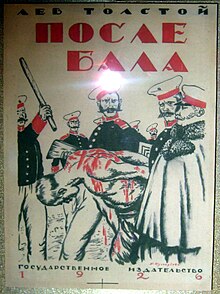After the ball

After the ball ( Russian После бала , Posle bala ) is a short story by Lev Tolstoy , written in 1903 and published posthumously in 1911.
content
The widely esteemed Ivan Wassiljewitsch tells a story from his youth when he is old. Back in the 1840s, as a student, he fell in love with the beautiful Warenka B., daughter of Colonel Pyotr Vladislavich B.
At the eponymous ball, Ivan Vasilievich describes the colonel as follows: “Warenka's father was a very good-looking, handsome old man with a strikingly fresh, rosy complexion ... and just like his daughter, a winning, happy smile shone in his eyes and played around him Mouth. With his broad, military-style chest adorned with a few medals, his bulging shoulders and long strong legs, he made an imposing impression. He was a typical old warrior of the Nikolaik school. "
At the ball, Ivan Wassiljewitsch dances the quadrille with Warenka . He doesn't want to find out whether Warenka loves him. It is enough for him that he loves her and hopes that his happiness will last as long as possible.
After the ball, the lover can't sleep and wanders across the meadow in the direction of the park. There, Colonel B. orders a gauntlet to run the gauntlet very early on . A Tatar is chastised for trying to escape from the troops. The colonel keeps pace with the delinquent, demands fresh gauntlet in the middle and slaps a recruit who hits too laxly.
The images of the inhumane criminal court burn themselves into Ivan Vasilievich's brain so deep that the disillusioned man neither becomes an officer nor ever enters the civil service. The end of the love for beautiful Warenka.
German-language editions
- After the ball. German by Arthur Luther . P. 70–82 in: Gisela Drohla (Ed.): Leo N. Tolstoj. All the stories. Seventh volume. Insel, Frankfurt am Main 1961 (2nd edition of the edition in eight volumes 1982)
- After the ball. Translated from the Russian by Hermann Asemissen . Pp. 162-174 in: Eberhard Dieckmann (Ed.) Lew Tolstoi. Haji Murat. Late stories (contains: Hajji Murat. After the ball. The fake coupon. Alyosha the pot. What for? The divine and the human. What I saw in dreams. Father Vasily. Power of the child. The monk-priest Iliodor. Who are the murderers? Conversation with a stranger. The stranger and the farmer. Songs in the village. Three days in the country. Children's wisdom. Grateful soil. Chodynka. Unwanted. Post-legacy records of the monk Fyodor Kuzmich. All the same. There are no guilty parties in the world ). 623 pages, vol. 13 by Eberhard Dieckmann (ed.), Gerhard Dudek (ed.): Lew Tolstoi. Collected works in twenty volumes . Rütten and Loening, Berlin 1986 (used edition)
- The stories. Vol. 2. Late stories. 1886–1910 (contains: The canvas knife . The death of Ivan Ilyich . The Kreutz sonata . The devil. Master and servant . Father Sergei. After the ball. Haji-Murad . The fake coupon. Aljosha the pot . Kornej Wasiljew. The strawberries. For what? The divine and the human. What I saw in a dream . On the Chodynka field ). Artemis and Winkler, Düsseldorf 2001. 813 pages, ISBN 978-3-538-06906-0
Web links
- The text
- После бала (Толстой) (Russian)
- After the Dance (English)
- online at Lib.ru / Classic (Russian)
- online at RVB.ru (Russian)
- Entry in the work list
- Entry at fantlab.ru (Russian)
- Marietta Boiko : Commentary on the text (Russian)
Individual evidence
- ↑ Edition used, p. 167, 7. Zvo
Remarks
- ↑ The events of the 1840s were more than 32 years ago. Because Warenka B. was 18 years old at the time: “... at the age of fifty she was still an unusually beautiful woman.” (Edition used, p. 163, 10th Zvo)
- ↑ Tolstoy tells from his life. The action takes place in Kazan . Ivan Vasilyevich is his eldest brother Nikolai (1823-1860), Warenka B. Varvara Andreyevna Qurei saddle (Russian Варварa Андреевнa Корейшa.) - daughter of the military commander Colonel Andrei Petrovich Qurei saddle (Russian Андрей Петрович Корейша.) (Taken from After the Ball (russ .)).